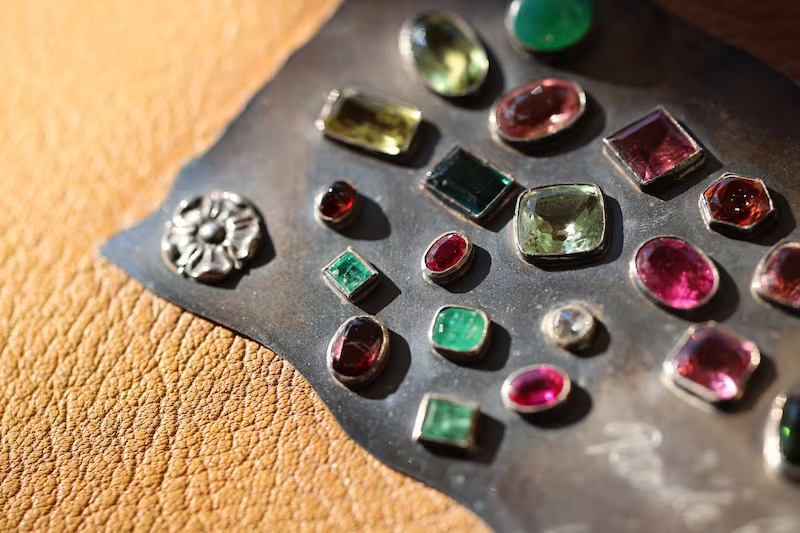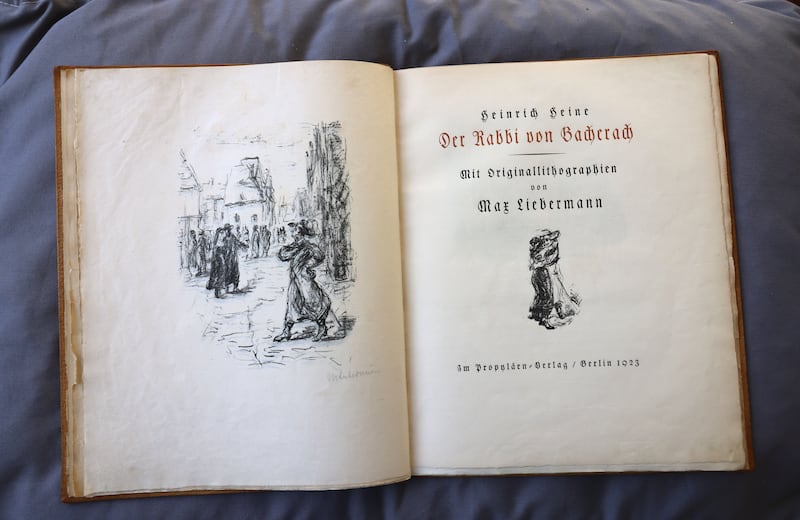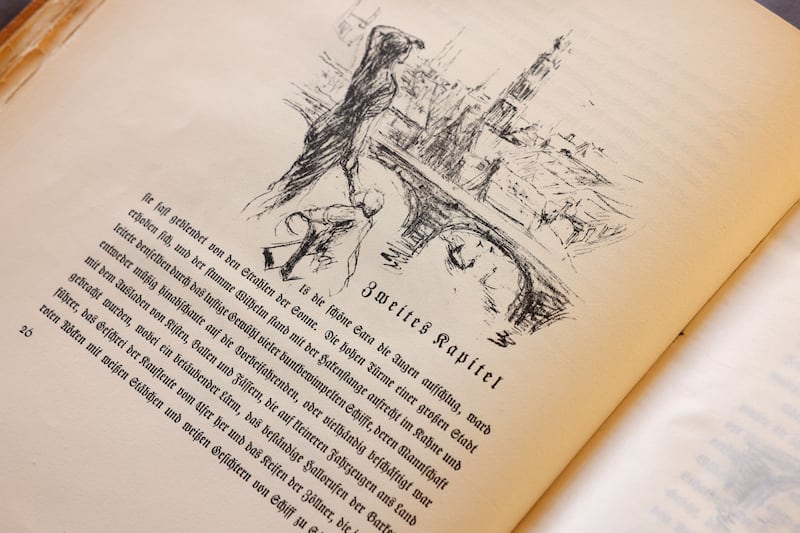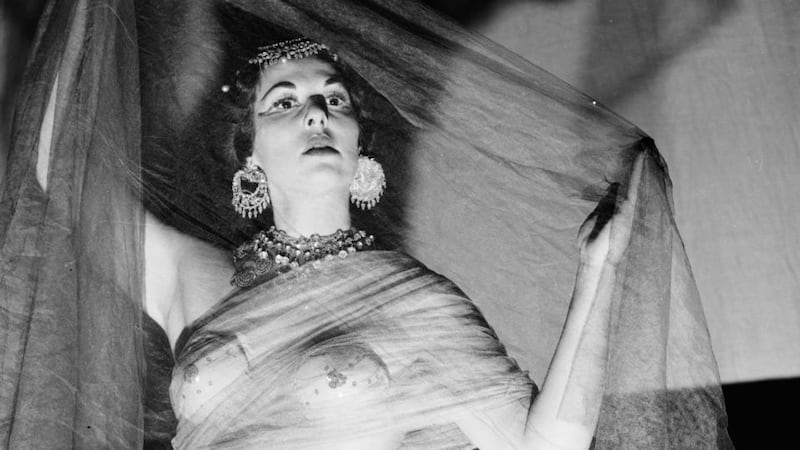In stories, or at least in the ones I loved as a child, magical objects appear when a lamp is polished, or a certain word is uttered, or a ring is rubbed. The end result is the same; something wonderful suddenly appears from nowhere. I am sitting in the lobby of a south Dublin hotel and looking in amazement at a fabulous treasure that has materialised unexpectedly out of the most modest of origins: a crinkled plastic supermarket bag.
Mark Leslie, son of the late German-born actor and singer Agnes Bernelle, is the person who has created this sleight of hand. There are four of us around the table; Mark, his two children Luke and Leah, and myself. A fifth, a waiter bringing teas and coffees, hovers uncertainly over us. We are all staring at what Agnes Bernelle knew as the Jewel Book; a family treasure that went missing for decades after the Bernelle family fled Berlin and the war, leaving all their possessions behind.
Bernelle, who died in 1999, was born in Berlin. The year of her birth, 1923, coincided with the publication of a limited edition of a story by the 19th-century writer, Heinrich Heine, with 17 etchings by artist Max Liebermann. The story was called The Rabbi of Bacharach, and was published in an edition of just 100.
Bernelle’s father, Rudolph Bernauer (she changed her surname later in life), gave this limited-edition book as a birthday gift to his business partner, Carl Meinhard. The two men owned a number of Berlin cabarets and theatres together. It was A4 size, with a soft pale yellow leather cover. Meinhard was clearly a forgetful kind of person, because on Bernauer’s next birthday, he was gifted back this very same book.
READ MORE

Bernauer returned the book the following year for his friend’s birthday, with the addition of a diamond set into the leather cover. And so a tradition began. The two men continued to swap the book back and forth on their birthdays, adding jewels to a piece of silver they had mounted on the cover to accommodate these gems. Rubies. Emeralds. Garnets. At some point, they added another silver plate to the cover, the dates of their annual exchange engraved on the silver. It was agreed that whoever survived the death of the first would inherit the book.
Bernelle was a child when she first saw this book, shown to her by her father. She was only 13 when the family escaped from Berlin to England before the outbreak of the second World War. All their belongings were left behind, including the Jewel Book.
Bernelle went on have a career as an actor and singer, and I was lucky enough to see her perform Weimar Cabaret in Dublin a couple of years before her death. She married Desmond Leslie in 1945, whose family home is Castle Leslie in Glaslough, Co Monaghan. They had three children together. They later split up, and she moved to Dublin and went on to marry architectural historian Maurice Craig.


“I was eight when Granny died,” her granddaughter Leah Leslie recalls. “What I remember most about her is the glamour. I loved her dress sense. I used to play in her bedroom and look at all her costume jewellery: it was like Aladdin’s Cave in there. I wear red lipstick now like she used to. She was always saying ‘Darling’ and she was very creative. There was always lots of drama.”
Leah remembers a Christmas when there was a family gathering that her grandmother was presiding over, with chaos going on in the kitchen. “The next thing, we saw the turkey moving across the floor.”
No, the turkey was not still alive, it was being propelled along the floor by the cat, which had got inside it while no one was looking and was now trying to exit its avian quarters. Leah was instructed by her mother to eat the ham instead.
The Strand Road house in Sandymount that Agnes Bernelle – known as “Aggie” to her family – and her husband Maurice Craig shared had other eccentricities. Leah recalls there being a curtain down the middle of the Bernelle-Craig marital bed. “Granny would pull it when she didn’t want to see him any more.”
When did Mark Leslie first hear about the lost Jewel Book? “I was aware that there were a whole load of items that had gone missing, and there was also a villa, and a 30-year hunt to find out what happened the contents,” he says.
Carl Meinhard spent five years in a concentration camp at Ravensbruck. After the war, he went to Argentina, where he had family. The two men never met again. Meinhard died before Rudolph Bernauer.
In 1996, Bernelle published a memoir, The Fun Palace, which covered her life up to 1969. There was a postscript at the end, added shortly before the manuscript was due to go to press. It was entitled “The Story of the Jewel Book”. In it, she wrote that she had become aware some years previously through a contact of her father’s that the book had somehow ended up in New York. It was, in fact, on display in the Central Synagogue there; part of an exhibition of Judaic Art, but without any of the context of its history.

Bernelle was told by the curator that the book had been “brought” to the US by a general in the army, and later donated to the Central Synagogue. She was never able to establish the circumstances of how the book ended up in the possession of a member of the military. It is common knowledge that countless precious items that belonged to families who were victims of war were either looted or sold on to third parties: repatriation of these items to their descendants remains an ongoing international story.
Bernelle was offered her own family treasure – for a price. For all sorts of reasons, she turned this offer down. The years passed, and the book was withdrawn from display. She made a further visit to the Central Synagogue, and spoke with the new curator, again telling her story. Invited to provide documentation of her connection to the book, she did so. By the time she had finished writing her memoirs in 1996, the news came that the book was to be returned to her.
The final line of her memoir is: “I hope to travel to New York before the year is out.”
In 2018, Luke Leslie, her grandson, uploaded a video to YouTube. It was a digitised version of the CBS news item that had been broadcast in 1996, when Agnes Bernelle was given the Jewel Book back, at a ceremony in the Central Synagogue. Mark Leslie had shown the clip to his children decades before, and the physical tape had been preserved safely.
“We had the clip on VHS tape, and I digitised it,” says Luke.
The clip is deeply moving and very beautiful; a rare happy story of a disappeared war treasure. In it, Bernelle says, as she holds the Jewel Book, “I never believed it would really happen, but here I am. Here we both are. Both survivors of the Holocaust.”
She then describes her family’s escape from Germany, and the readjustment to their new life. “The book was forgotten. It was forgotten, because compared to all the other things that we lost, it was really quite a small item. It was only a book. It was only a few jewels. Now of course, this has totally changed. Because it is the only thing of any value that has survived in my family.”
The Jewel Book is now in the care of Mark, who keeps it in a secure place outside his home. He is now writing a memoir, and if his loquacious conversation is anything to go by, it will be lengthy and extremely entertaining.





















